Are you wondering what lizard you see in your yard? Are you wondering if it’s native to Florida?
Here is a list of all 56 lizards in Florida, along with whether they are native to the area or introduced.
1. Northern Curly Tailed Lizard
Scientific name: Leiocephalus carinatus.
Common name: northern curly-tailed lizard.
Establishment: Introduced
The Northern curly-tailed lizard is native to the Bahamas, Cayman Islands, and Cuba and was introduced in Palm Beach, Florida intentionally to control the pests in the sugar canes. It can now be found in other parts of Florida.
Adults grow to 10 inches (26cm) in total length, including the tail, which is curled upwards.

These are active lizards and will run and hide if scared.
They live in sunny areas with plenty of rocks and rubble.
They play dead if captured and handled and will remain motionless for a while, even when they have been put back on the ground.
2. Red Sided Curly Tailed Lizard

Scientific name: Leiocephalus schreibersii.
Common name: Hispaniolan curlytail lizard, Hispaniolan khaki curlytail, red-sided curly-tailed lizard, Schreibers’ curly-tailed lizard.
Establishment: Introduced
The red-sided curly-tailed lizard is active during the day.
This lizard belongs to the Leiocephalidae family and runs quickly to escape predators.
Growing up to 6cm in body length, excluding the tail, they are fast and will run for cover if approached.
3. Indo-Chinese Forest Lizard
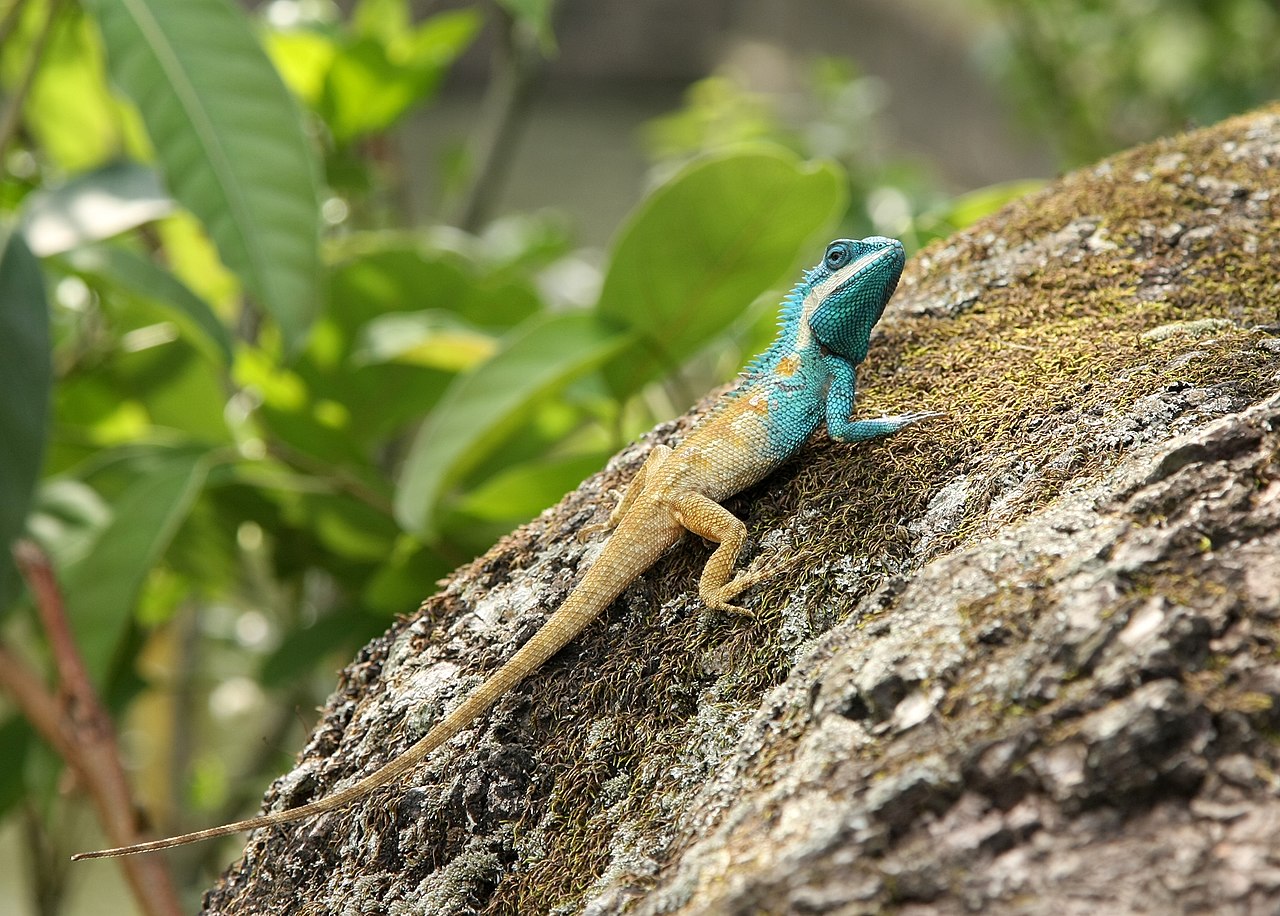
Scientific name: Calotes mystaceus.
Common name: Indo-Chinese forest lizard, blue crested lizard.
Establishment: Introduced
The Indo-Chinese Forest lizard has smooth scales with small spines on both sides of the head.
They have a compressed tail and an overall body color of olive to gray with red spots on the back and yellow on the lips.
They grow up to 42cm in total length, including the tail.
4. Common agama
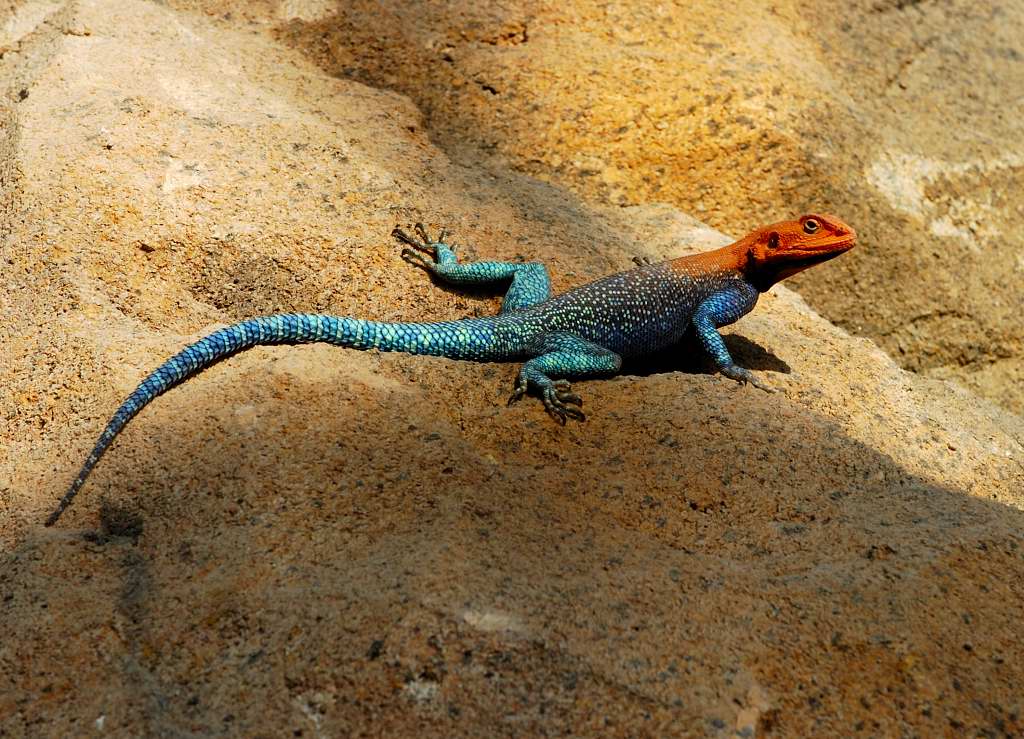
Scientific name: Agama agama.
Common name: common agama, red-headed rock agama, rainbow agama.
Establishment: Introduced
The common agama is brown or gray in color, but they do go through color changes during the breeding season, where they can turn bright blue, red, or yellow.
This is a very common lizard with a yellow or red head and is well adapted to living in household yards, grasslands, and bushy areas.
Even though they look ferocious, they are very shy and will run for cover if approached.
Further Reading:
5. Butterfly lizard

Scientific name: Leiolepis genus.
Common name: butterfly lizards, butterfly agamas.
Establishment: Introduced
Named for its beautiful markings on its side and back, the butterfly lizard has yellow spots on the back and orange and black lines on the sides.
They were introduced to Florida and have established a healthy population.
They prefer living on land that is prepared for agriculture, along with sandy areas along the coastline.
6. Oriental Garden Lizard

Scientific name: Calotes versicolor.
Common name: oriental garden lizard, eastern garden lizard, Indian garden lizard, common garden lizard, bloodsucker, changeable lizard.
Establishment: Introduced
The oriental garden lizard gets a beautiful red throat during the breeding season.
They grow up to 14.5 inches (37cm) in total length, including the tail.
Their base color is a brown olive, but they can change to black or bright red.
They can often be seen hiding in a bush with black limbs and tail with a bright yellow and red head and neck.
The colors are common in males during mating season, which runs from May to October.
7. Green anole

Scientific name: Anolis carolinensis.
Common name: Green anole, Carolina anole, Carolina green anole, American anole, American green anole, North American green anole, red-throated anole, American chameleon.
Establishment: Native
Green anoles are small to medium lizards that are very slender with long pointed heads.
Males have a throat fan that is three times larger than the female, it is also bright red in color, where females’ throat fans are lighter, normally a white to pale pink.
Females can be distinguished by the white stripe on their spine, which males do not have.
They can grow up to 8 inches (20cm) in total length, of which up to seventy percent of this length is tail.
Further Reading:
8. Brown anole

Scientific name: Anolis sagrei.
Common name: brown anole, Cuban brown anole, De la Sagra’s anole.
Establishment: Introduced
Brown anoles are light brown with black or dark brown markings on their backs with tan to light lines on the sides. They have the ability to change color, usually to a darker brown. Their throat fan can be orange-red to yellow in color.
Males grow to around 8 inches (20cm) in total length with females being slightly smaller, around 5.9 inches (15cm) in total length.
Further Reading:
9. Bark anole

Scientific name: Anolis distichus.
Common name: bark anole, North Caribbean bark anole, Hispaniolan gracile anole.
Establishment: Introduced
The bark anole, also known as the North Caribbean bark anole or Hispaniolan gracile anole is native to the Bahamas and Hispaniola. It was introduced to Florida in the 1940s.
This anole spends the majority of its time basking in the sun on tree trunks.
They range in color from green to brown/gray with an orange, red or yellow throat fan.
They are small anoles growing to around 5 inches (12.7cm) in total length, including the tail.
10. Knight anole

Scientific name: Anolis equestris.
Common name: knight anole, Cuban knight anole, Cuban giant anole.
Establishment: Introduced
Knight anoles are large anoles, growing to 20 inches (51cm) in total length, this includes their tail which is longer than their body.
Males are larger than females and are usually bright green with a yellow stripe present on the side of the head and on the shoulder.
Their throat fan is pink/white.
Juveniles can be identified for their light banding on the body.
These anoles are active during the day and highly territorial and will face any threat.
11. Common Puerto Rican anole

Scientific name: Anolis cristatellus.
Common name: crested anole, common Puerto Rican anole, Puerto Rican crested anole.
Establishment: Introduced
The common Puerto Rican anole is much more muscular and stockier than the other anoles, it is also more aggressive.
It is a small anole only growing to around 3 inches (7.5cm) excluding the tail. Females are smaller than males.
Males can be identified by their fin-like sail that runs down their tails.
They vary in color from green/gray to bronze with light brown spots and a green to yellow belly with a burned orange throat fan.
Juveniles are very different and are brown with bands and purple/brown spots on the throat.
They also have a light mid-dorsal stripe, which some of the females will keep as they age.
12. Large-headed anole

Scientific name: Anolis cybotes.
Common name: large-headed anole, Tiburon stout anole, largehead anole, Hispaniolan stout anole.
Establishment: Introduced
The large-headed anole comes from Hispaniola and the small islands surrounding it. It was introduced to South Florida where it has stable breeding populations.
The males have large heads. They are brown with lighter stripes on the sides.
13. Cuban green anole
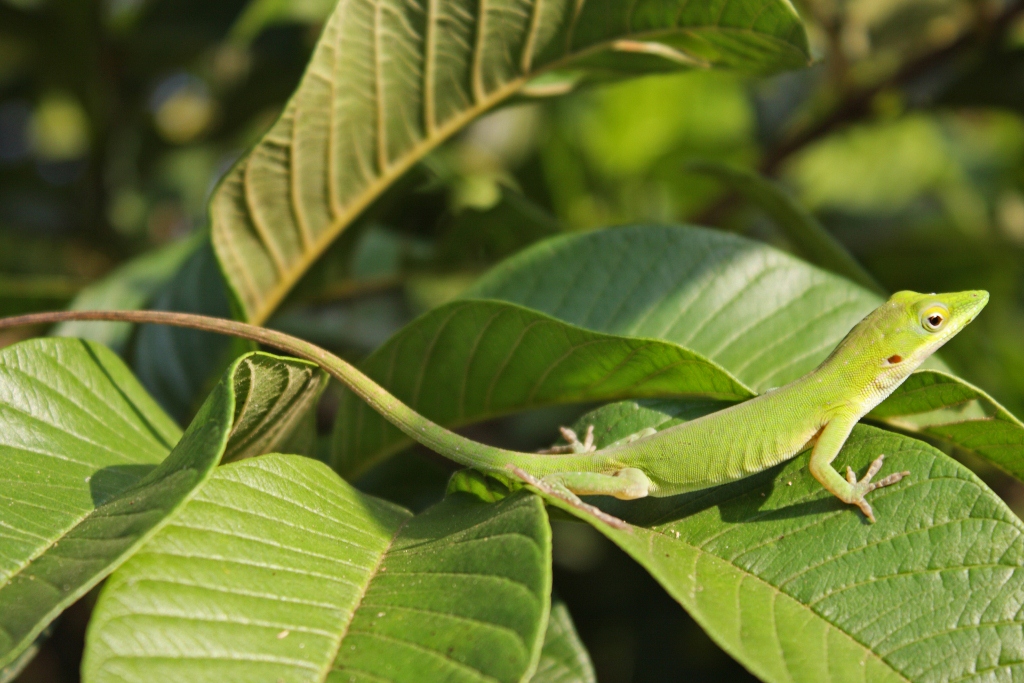
Scientific name: Anolis porcatus.
Common name: Cuban green anole.
Establishment: Introduced
The Cuban green anole belongs to the Carolinensis group of anoles and is native to Cuba. It was introduced to Florida and has stable breeding populations throughout the state.
14. Hispaniolan green anole

Scientific name: Anolis chlorocyanus.
Common name: Tiburon green anole, Hispaniolan green anole, Jeremie anole.
Establishment: Introduced
The Hispaniolan green anole is native to Hispaniola Island and is very similar to the green anole from North America.
You can identify them for males having light blue throat fans, where the North American green anole has red.
Females and juveniles have dark green stripes on the side of their bodies and males are bright green.
Their habitat is southern Florida.
15. Jamaican giant anole

Scientific name: Anolis garmani.
Common name: Jamaican giant anole, Jamaican anole, Jamaica giant anole.
Establishment: Introduced
The Jamaican giant anole is a large anole that grows to 10.6 inches (27cm) in total length, including the tail.
They are green but turn brown at night.
Males have orange in the center of their throat fan. Females have a small and dusky-looking throat fan.
16. Florida scrub lizard

Scientific name: Sceloporus woodi.
Common name: Florida scrub lizard.
Establishment: Native
The Florida scrub lizard is around 5 inches (13cm) including the tail.
They are brown or gray with brown stripes down either side of their body.
Males have turquoise on their belly and throat. Females lack the turquoise and may have some light patches on their bellies.
They prefer living in the scrub, which includes sand pine and evergreen oak scrub. They are more common in dry open areas when they bask in the sun.
17. Eastern fence lizard
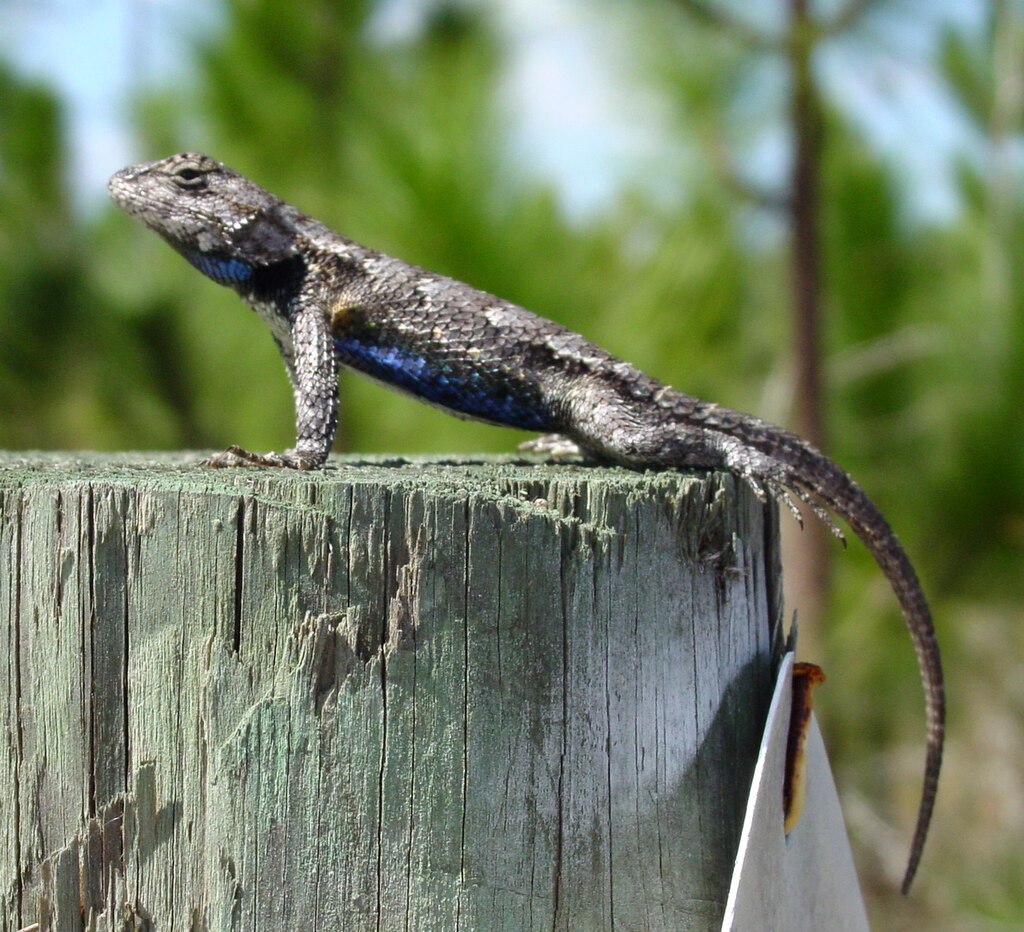
Scientific name: Sceloporus undulatus.
Common name: eastern fence lizard, prairie lizard, fence swift, gray lizard, northern fence lizard, pine lizard.
Establishment: Native
Eastern fence lizards can grow to 7.5 inches (19cm), including the tail.
They are brown or gray in color with keeled scales and a dark line that runs at the back of the thigh.
Females are gray with some dark and wavy lines on the back with white bellies and black spots. Some females have light blue on the belly and throat. Males are brown in summer, with green/blue and black on the sides of their throat and belly.
They live in wooded areas with an abundance of sunlight, with loose or sandy soil. They bask in the sun on a host of structures including fence posts, logs, rock piles, and tree stumps.
They are active in the mornings and will hide when it gets too hot.
Further Reading:
18. Green iguana

Scientific name: Iguana iguana.
Common name: green iguana, American iguana, common green iguana.
Establishment: Introduced
Green iguanas are large and can grow to 5.6 feet (1.7m) in total length, including the tail. The tail is longer than the body.
Males can weigh up to 4kg with females being slightly smaller, weighing up to 3kg.
They are easily identified for the row of spines on their tails and back, which protects them against predators.
They have whip-like tails, which give a very painful strike. They can break their tails, if they are grabbed, enabling them to escape. They can regenerate their tails.
They have a very well-developed throat fan, used for territorial and breeding displays.
They will try and flee if they feel threatened and will also dive into the water to escape.
19. Black spiny-tailed iguana

Scientific name: Ctenosaura similis.
Common name: black spiny-tailed iguana, black iguana, black ctenosaur.
Establishment: Introduced
The black spiny-tailed iguana has black keeled scales on its tails.
Males can grow up to 4 foot 3 inches (1 meter) in total length, which their tails and females being slightly smaller.
Their spines run down the center of their backs with colors varying.
Adults can be tan or gray with dark bands. Males develop orange on their heads and throats during mating season, along with blue and peach on their jowls.
They were introduced to South Florida and survive in feral populations. They have been discovered from North Collier County to Tampa Bay, along with Key Biscayne, Broward County, and Hialeah.
20. Mexican spiny-tailed iguana

Scientific name: Ctenosaura pectinata.
Common name: western spiny-tailed iguana, Mexican spinytailed iguana, spiny-tailed iguana, black spiny-tailed iguana, Guerreran Spiny-tailed Iguana, broad-ringed spiny-tailed iguana.
Establishment: Introduced
Mexican spiny tail iguanas are large lizards that grow to 1.3 meters in length, females are slightly smaller.
They are gray/brown to brown in color with yellow on their belly.
Their long spines run down the center of the back.
Juveniles are bright green with no pattern, they darken as they age.
They are native to Western Mexico and were introduced to South Florida, where they survive in feral populations.
They can be found in Broward County, Key Biscayne, and Hialeah. They are also found on Gasparilla Island, where they have reproduced after three pet iguanas were released by a resident back in 1970.
21. Brown Basilisk

Scientific name: Basiliscus vittatus.
Common name: brown basilisk, striped basilisk, common basilisk.
Establishment: Introduced
Brown basilisks can grow up to 24 inches (61cm) in total length, which includes the tail.
They have a three-part crest on their heads, back, and tail.
They are olive-brown to brown in color with back cross banding, which can be seen on the dorsal crest and flanks. They have a white stripe that runs from the eye to the back legs.
Males have a large crest. They have long shoes with very sharp claws.
These lizards have the ability to run on water for about 20 meters (66 feet) without sinking. Younger brown basilisks can run further than the older lizards. They have flaps on their back feet which open, providing more surface area to allow them to run on water.
Futher Reading:
22. Veiled chameleon

Scientific name: Chamaeleo calyptratus.
Common name: veiled chameleon, cone-head chameleon, Yemen chameleon.
Establishment: Introduced
The veiled chameleon is a large chameleon lizard that can grow to 24 inches (61cm) in total length, including the tail.
Females tend to be shorter and thicker than males.
Juveniles are green and develop stripes as they age.
Adult females are green with orange, white, yellow, and tan mottling, while males are brighter with defined yellow or blue bands and some mottling.
Their coloration is affected by a host of conditions from heat to stress.
They can be found in mountains and valleys, where they live in trees and large plants, preferring warmer temperatures. They live in the wild in Florida, most of which are escaped pets that have established stable populations.
Further Reading:
23. Oustalet’s chameleon

Scientific name: Furcifer oustaleti.
Common name: Malagasy giant chameleon, Oustalet’s chameleon.
Establishment: Introduced
This introduced chameleon is considered the largest chameleon species growing up to 27 inches (68.5cm) in total length.
Their heads have a tall casque with crests and small triangular spines that run down the center of the spine.
They are usually brown or gray and females are more colorful than males.
The Oustalet’s chameleon is native to Madagascar and has been introduced to Florida where they can be found in forest and agricultural areas, along with urban areas.
24. Jackson’s chameleon

Scientific name: Trioceros jacksonii.
Common name: Jackson’s chameleon, Jackson’s horned chameleon, three-horned chameleon, Kikuyu three-horned chameleon.
Establishment: Introduced
Jackson’s chameleons are also known as three-horned chameleons, due to the males having three brown horns, one of the nose and one on top of the orbital ridge, just above the eyes.
Females do not possess the horns.
They are bright green in color with some having yellow or blue traces.
They are able to change color based on health, mood, and temperature.
Adults can grow to 15 inches (38cm) including their tails with females being slightly smaller.
25. Six-lined Racerunner

Scientific name: Aspidoscelis sexlineatus.
Common name: six-lined racerunner.
Establishment: Native
Six lined racerunners are brown, black, or dark green and have six green/yellow to yellow stripes running from their heads to their tails.
Females have white bellies; males have light blue. Males also have a pale green throat.
The tail is double the length of their slender bodies.
They are very wary and can move at speeds of up to 29 kilometers per hour.
They live in a range of habitats from open floodplains and grasslands to rocky outcrops and woodlands.
26. Giant Ameiva

Scientific name: Ameiva ameiva.
Common name: giant ameiva, green ameiva, South American ground lizard, Amazon racerunner.
Establishment: Introduced
The giant ameiva has a pointed head with a forked tongue and a streamlined body with muscular back legs.
They can grow to 20 inches (50cm) in total length.
Males are bright green, while females are lighter in color, both have black spots and mottling on their sides.
They live on the ground, preferring forests where they can hide in leaf litter and under logs.
27. Rainbow Whiptail
Scientific name: Cnemidophorus lemniscatus.
Common name: rainbow whiptail.
Establishment: Introduced
The rainbow whiptail is a Central American and Caribbean lizard that has been introduced to Florida, where it has established stable populations.
They grow to around 12 inches (30.5cm) and will run if approached.
28. Argentine black and white tegu

Scientific name: Salvator merianae.
Common name: Argentine black and white tegu, Argentine giant tegu, black and white tegu, huge tegu, lagarto overo.
Establishment: Introduced
When they first hatch, these lizards are a beautiful emerald green from their nose to the back of the neck, combined with black markings. The green becomes black after a few sheds.
Juveniles have yellow and black bands on their tails which becomes solid yellow bands as they age. The less solid bands on the tail, the older the lizard is.
They can break their tails as a form of escape. Their tails are strong and can be used as a whip.
They run at exceptionally high speeds when running for shelter.
Males can grow to 140cm (4.5 feet) in total length.
The tegu is sometimes kept as an exotic pet and has proven to be exceptionally intelligent and can be housebroken.
29. Reef gecko

Scientific name: Sphaerodactylus notatus.
Common name: Florida reef gecko, brown-speckled sphaero.
Establishment: Native
Reef geckos are secretive and small with round bodies and large keeled scales on their backs.
They hide in debris and leaf litter and is considered one of the smallest lizards in the United States, growing to 2.25 inches (5.7cm) in total length.
They have a brown body with dark spots.
Females have three wide dark stripes on their heads.
They can be found from the Florida Keys to southeastern Florida. They prefer vacant lots, pinelands, and hammocks.
They are mostly active at dusk, where they can be seen running from one hiding place to another in search of food.
30. Ocellated gecko
Scientific name: Sphaerodactylus argus.
Common name: ocellated gecko, ocellated sphaero, stippled sphaero.
Establishment: Introduced
The ocellated gecko comes from Jamaica and has been introduced to the Florida Keys, where it has established stable populations.
They prefer forest areas but are often seen in urban areas on the walls of homes and in buildings.
31. White-spotted wall gecko
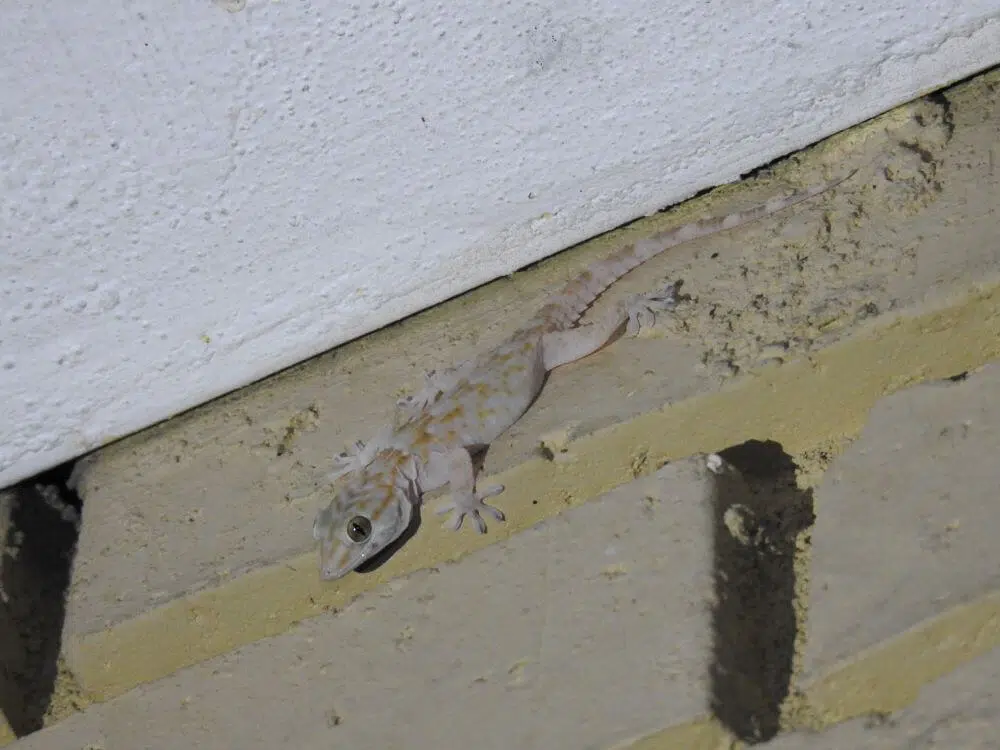
Scientific name: Tarentola annularis.
Common name: white-spotted wall gecko, ringed wall gecko.
Establishment: Introduced
This large gecko can grow up to 8 inches (15cm) in total length.
They are gray to tan with four white spots on their shoulders and bulging eyes.
Their skin has a wart-like appearance.
They originally come from the Saharan areas and have been introduced into a number of Florida locations. In Florida, you find these lizards on the walls of buildings and they will bite if you grab one.
32. Flat-tailed House Gecko
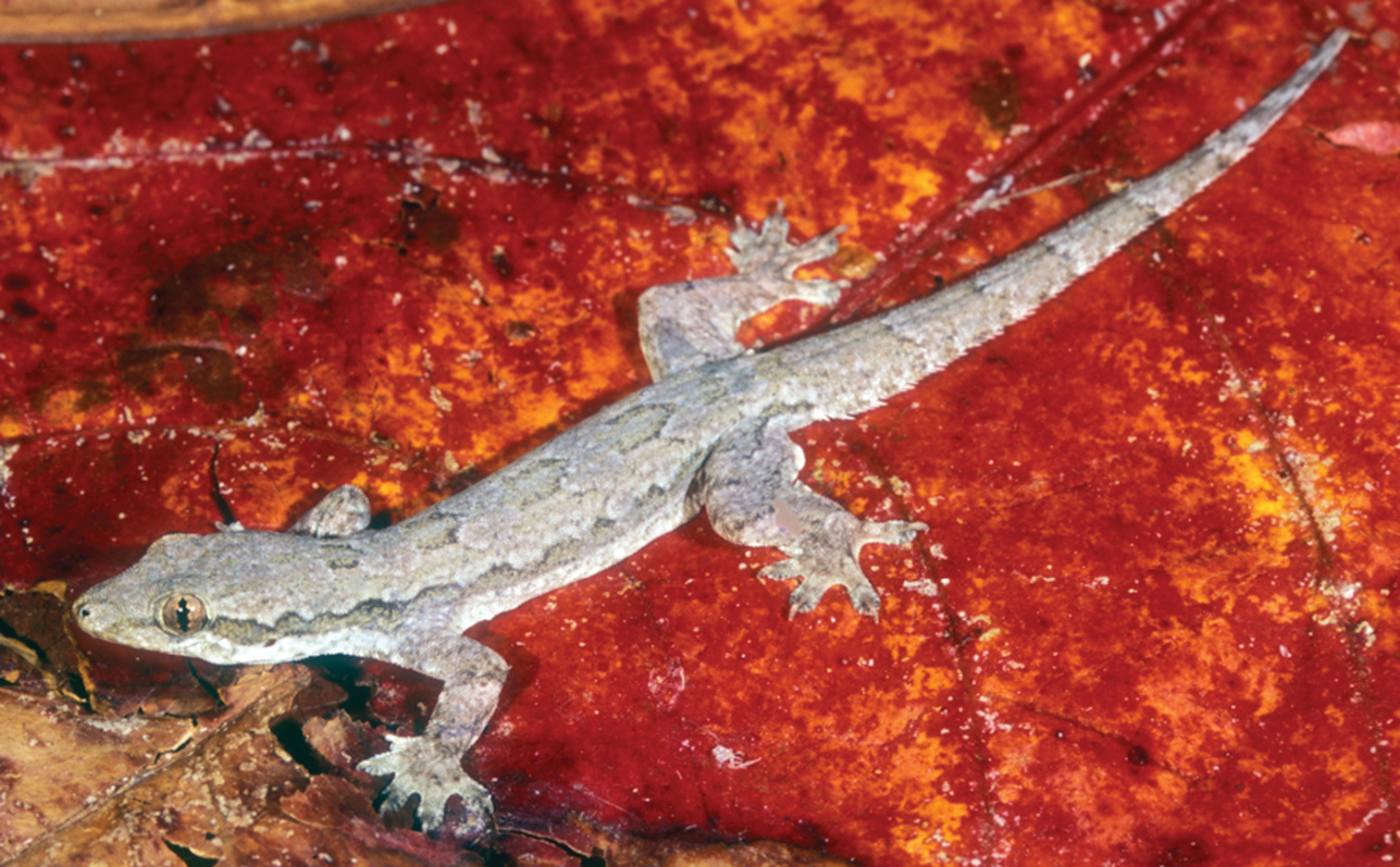
Scientific name: Hemidactylus platyurus.
Common name: flat-tailed house gecko, frilled house gecko, Asian house gecko.
Establishment: Introduced
The flat-tailed house gecko has a long snout and a concave forehead. They have flat tails with a sharp lateral edge. They are gray in color with a dark band from their eye to their shoulders.
They can grow up to 6cm in body length, with the tail longer than the body.
They were introduced to Florida and can be found in Miami-Dade, Pinellas, Lee, Broward, and Alachua counties.
33. Ashy gecko

Scientific name: Sphaerodactylus elegans.
Common name: ashy gecko.
Establishment: Introduced
The ashy gecko was first discovered in Florida in 1922.
They are native to the West Indies and are believed to have come to Florida on a cargo shipment.
They have not moved into the rest of the United States and are mostly confined to the Florida Keys area.
They grow to only 3.9cm in total length and are green with a red or blue tail and bands on their bodies. There is no difference between the female and the male.
Further Reading:
34. Tokay gecko

Scientific name: Gekko gecko.
Common name: tokay gecko.
Establishment: Introduced
The Tokay gecko is large and can reach up to 12 inches (30cm) including the tail.
Its body is flat, yet cylindrical with soft skin which is gray with red patches.
Their color can change, helping them blend in easily with their environment.
Males tend to be larger and brighter than the female.
They are territorial and aggressive and can give a nasty bite.
The Tokay gecko is also an excellent climber.
35. Mediterranean house gecko

Scientific name: Hemidactylus turcicus.
Common name: Mediterranean house gecko, Turkish gecko, moon lizard.
Establishment: Introduced
This small house gecko grows to around 5 inches (13cm) in total length.
They have sticky toe pads and large eyes. They are gray in color with dark patches.
They are often seen around outside lights at night, as they prey on insects attracted by the light.
They are an Old World species of gecko that is native to Northern Africa and Southern Europe. They have established populations in Florida and the Florida Keys.
They are nocturnal and can be found in crevices and cracks.
36. Tropical house gecko

Scientific name: Hemidactylus mabouia.
Common name: tropical house gecko, Afro-American house gecko, cosmopolitan house gecko.
Establishment: Introduced
The tropical house gecko can grow to 5 inches (12.7cm) in total length.
They are nocturnal, coming out to hunt for prey at night.
They can slowly change color to match their surroundings from a light brown to a dark brown.
They are mostly found in urban areas.
They are vocal and make fast, short squeaking sounds.
37. Bibron’s thick-toed gecko
Scientific name: Chondrodactylus bibronii.
Common name: Bibron’s thick-toed gecko, Bibron’s sand gecko, Bibron’s gecko.
Establishment: Introduced
This is a very powerful gecko that is armored in appearance.
They have large heads and short legs with swollen toepads.
They can range from gray to brown to tan and usually have dark bars with scattered white tubercles.
The Bibron’s thick-toed gecko in Florida can grow up to 5.5 inches (14cm) and are smaller than those found in Africa.
These geckos are native to southern Africa and were introduced to Florida in the 1970s.
They will bite if provoked and an adult gecko can draw blood.
38. Indo-Pacific gecko
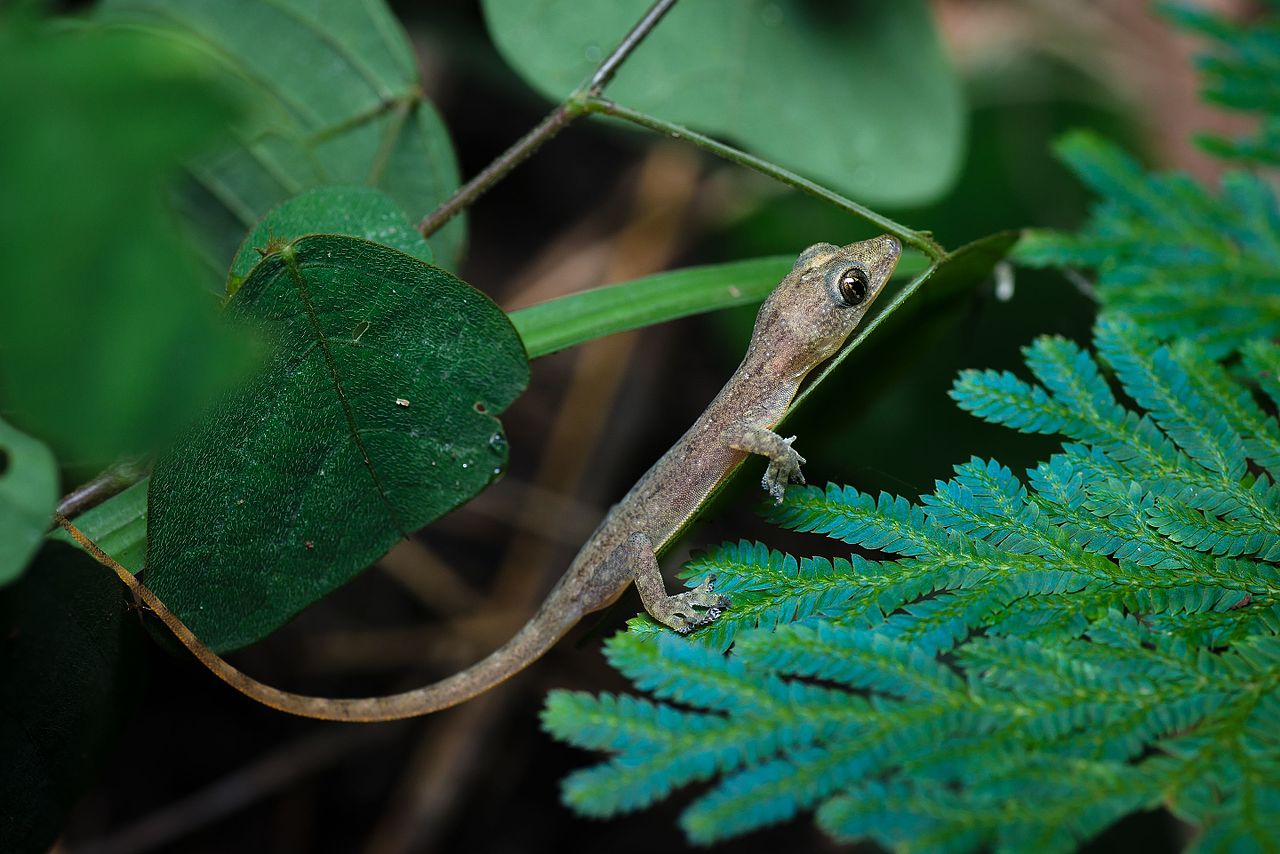
Scientific name: Hemidactylus garnotii.
Common name: Indo-Pacific gecko, Garnot’s house gecko, fox gecko, Assam greyish brown gecko.
Establishment: Introduced
The Indo Pacific gecko has a flat tail with a row of spine-like scales on the edge of the tail. They have an orange to yellow belly and dark gray to brown body.
At night they look translucent.
Adults can grow up to 5.5 inches (14cm) in total length.
They are common in southern Florida. They are an all-female population that are excellent climbers, coming out at night to hunt on insects.
39. Yellow-headed Gecko
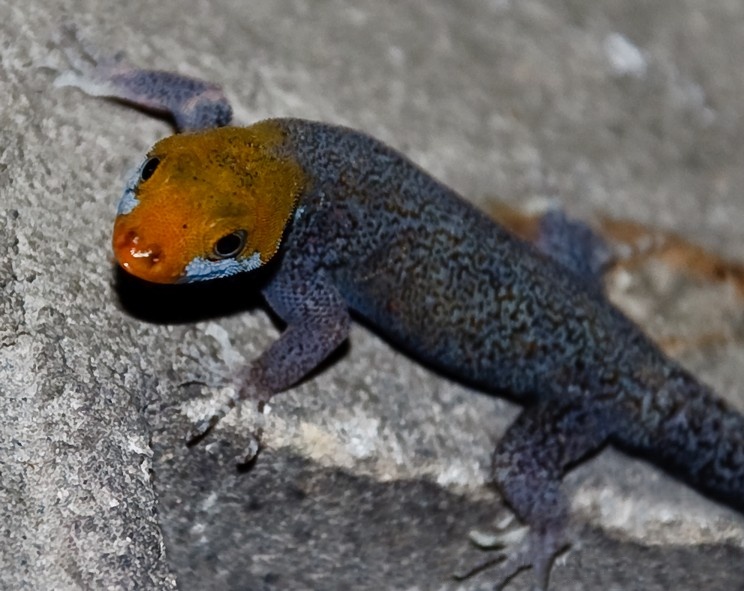
Scientific name: Gonatodes albogularis.
Common name: Yellow-headed gecko.
Establishment: Introduced
Yellow-headed geckos grow to 3.5 inches (9cm) in total length. Males have yellow heads, dark blue bodies, while females tend to be a mottled gray.
When they are basking in the sun, they fade to a blue-green, or gray color.
They have a white tip on their tails.
Native to the West Indies, they were introduced to the Florida Keys and are commonly found in rock piles and on buildings.
40. Madagascan giant day gecko

Scientific name: Phelsuma grandis.
Common name: Madagascar giant day gecko.
Establishment: Introduced
The Madagascan giant day gecko can grow up to 12 inches (30cm) in total length.
They are bright green or blue-green in color with a red stripe that runs from their eye to their nostril.
They have red bars or dots on their backs, though some have blue dots and others the dots are completely absent, but the red strip from their eye is always present.
They are native to northwest Madagascar and have been introduced in Florida with a few recorded populations.
41. Mole Skink
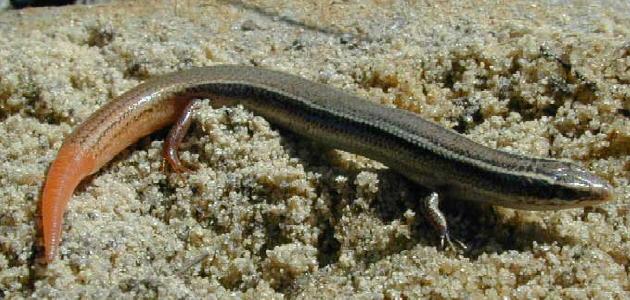
Scientific name: Plestiodon egregius.
Common name: mole skink.
Establishment: Native
Mole skinks can grow up to 6 inches (15cm). They are very slender with short legs and very long tails.
They can range from brown to gray with two light stripes that run on either side of their bodies. Their tails are orange or red and stay that color into adulthood. It is easy to distinguish because of its tail.
They love to burrow, seeking out arreas with loose soil.
They do prefer drier and hotter climates and are often found under logs, objects, boards, and leaf litter.
They are the most common skink in coastal dunes. They wriggle through the sand at fast speeds to escape predators and will break their tails as a means to escape.
42. Coal Skink

Scientific name: Plestiodon anthracinus.
Common name: coal skink.
Establishment: Native
Cole skinks are medium-sized lizards growing to 7 inches (18cm) in length with a streamlined body and short legs.
They are brown or gray with two yellow or white stripes on the side of their body.
They do not have a stripe down their backs, unlike the other skinks, making them easier to identify.
They are usually found in forest areas and along streams, where they prefer a moist habitat. They find shelter under rocks and logs. They will dive into the water and hide under debris if threatened.
They also break their tails, which gives them a chance to escape.
43. Sand Skink

Scientific name: Plestiodon reynoldsi.
Common name: Florida sand skink.
Establishment: Native
The sand skink has adapted to live underground.
They can grow up to 5 inches (13cm) in length, including their tails. They are tan or gray in color with tiny legs. Their tails are half their total length.
They have only been observed in Central Florida with one hundred and fifteen known sites.
They are not easy to find and live in vegetated areas with moist soil.
44. Broadhead Skink

Scientific name: Plestiodon laticeps.
Common name: broad-headed skink, broadhead skink.
Establishment: Native
Broadheaded skinks can grow up to 13 inches (33cm) in total length and the females are smaller than the male. They can weigh up to 70g.
Their glossy body has small scales, males are more colorful than the female and tend to be glossy olive-brown to brown in color with a bright red head during the breeding season. Females have light stripes down their backs and look similar to the five-lined skink.
They can be found scurrying between leaf litter and in moist soil. They are often observed in decaying trees, rotten logs, and sawdust piles.
45. Ocellated skink

Scientific name: Chalcides ocellatus.
Common name: ocellated skink, eyed skink, gongilo.
Establishment: Introduced
The ocellated skink has a cylindrical body and small head, growing up to 12 inches (30cm), including the tail.
They can weigh up to 39 grams and are often found in drier areas.
They are found in a host of environments including gravel deserts and farmland. They hide behind vegetation as a way to escape predators, as they are not fast runners.
46. Rough mabuya

Scientific name: Eutropis rudis.
Common name: rough mabuya, brown mabuya.
Establishment: Introduced
The rough mabuya is also known as the brown mabuya and is usually found in Southeast Asia, Indonesia, Malaysia, and the Philippines.
It was introduced to Florida, but not much is known about this rarely observed and secretive skink.
47. Rainbow mabuya

Scientific name: Trachylepis quinquetaeniata (formerly Mabuya quinquetaeniata).
Common name: African five-lined skink, rainbow mabuya.
Establishment: Introduced
This medium-sized lizard can grow up to 20cm in total length and vary in color, depending on its age and gender.
They have glossy scales which show a metallic reflection.
Their base color is usually dark brown or olive-brown with pearl white spots and three yellow to orange stripes that run from their heads to their bright blue tail. As they age, the stripes often fade.
They have a pointed nose with black spots just behind the ear opening.
They are native to Africa and have been introduced to Florida.
48. Five-lined Skink

Scientific name: Plestiodon fasciatus.
Common name: (American) five-lined skink, blue-tailed skink (for juveniles) and red-headed skink (for adults), eastern red-headed skink.
Establishment: Native
The five-lined skink is considered a small to medium-sized lizard that grows to 8.5 inches (21.5cm) including the tail.
Juveniles are black to dark brown with five yellow to white stripes and an electric blue tail. The blue tail fades with age to a light blue and the stripes may disappear completely.
Their dark brown also fades with most adults being uniform brown.
These are ground-dwelling lizards that prefer a wooded and moist habitat. They are often found inside building walls.
49. Southeastern Five-lined Skink
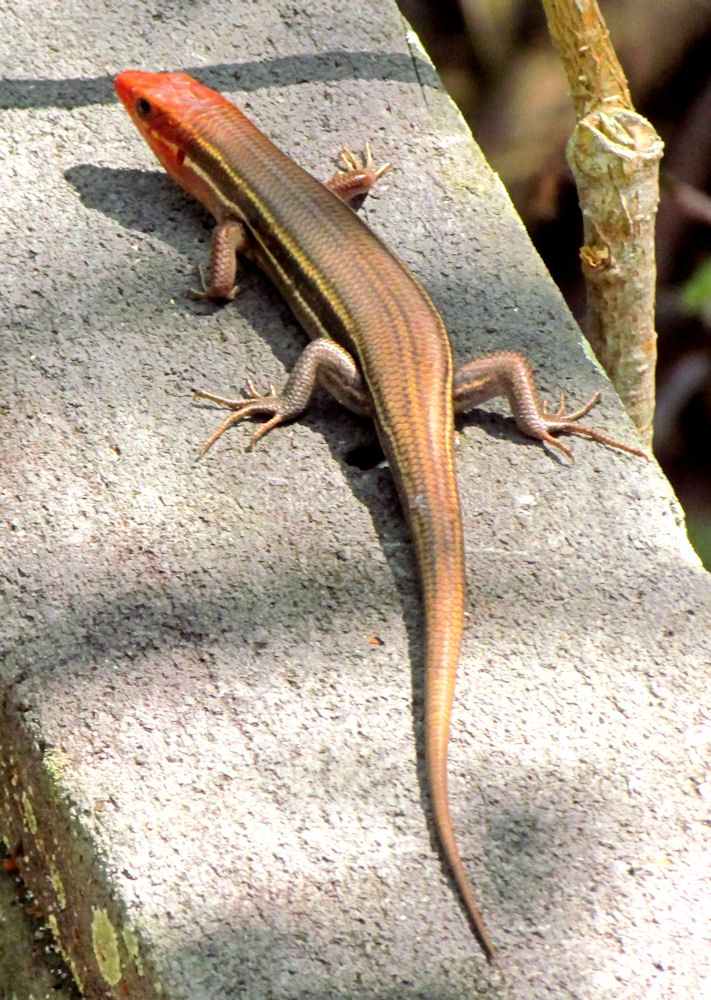
Scientific name: Plestiodon inexpectatus.
Common name: southeastern five-lined skink.
Establishment: Native
The southeastern five-lined skink grows to 8.5 inches (21.5cm) in total length with a gray, black, or brown body with five yellow to white stripes.
The stripes are one down the center of the back and two on either side of the streamlined body.
Juveniles have bright blue tails, males often lose their stripes, developing an orange to red color on the head.
They are often observed in trees and on the ground in dry wooded habitats where there is plenty of tree stumps to hide in.
They are not easy to capture and run away and hide quickly. They will break their tail in order to escape predators.
50. Eastern Glass Lizard
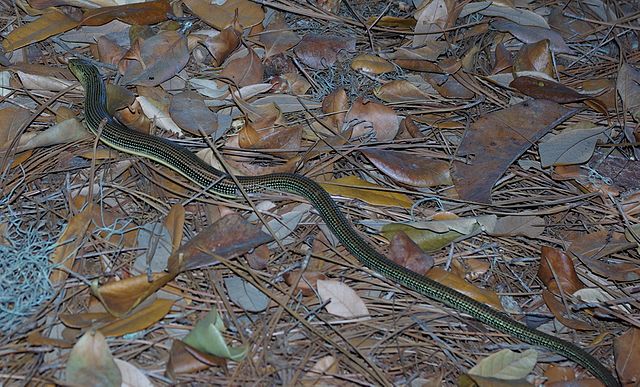
Scientific name: Ophisaurus ventralis.
Common name: eastern glass lizard.
Establishment: Native
The eastern glass lizard is a long and slender lizard without legs.
They can grow up to 43 inches (108cm) in total length.
This is the heaviest and longest of the glass lizards in Florida and is yellow, brown, or green in color.
They are found in a variety of habitats, though they are most common in wetlands with sandy habitats. They are common in coastal dune areas.
They are very active during the day and can be observed in open areas, but they will run and hide if approached.
If captured, they break off their tail, which continues to wriggle, distracting their predator as they escape.
51. Slender Glass Lizard

Scientific name: Ophisaurus attenuatus.
Common name: slender glass lizard.
Establishment: Native
Slender glass lizards are legless lizards which are long and slender, looking similar to a snake.
They can grow up to 42 inches (107cm) in total length.
They are brown to yellow in color with dark markings, which may fade as the lizard gets older. Many have a dark stripe that runs down their backs.
They prefer dry habitats and are often observed in sandy areas.
They are active during the day and will run and hide if approached.
These lizards will also break off a portion of their tail, which helps to distract any predators, as they escape.
52. Mimic Glass Lizard

Scientific name: Ophisaurus mimicus.
Common name: mimic glass lizard, rainbow glass lizard.
Establishment: Native
The mimic glass lizard grows up to 26 inches (66cm) in total length and is smaller than many of the other glass lizards in Florida.
It is yellow to brown in color with a number of dark stripes, which run down the sides of the body.
They prefer dry habitats and are often found in flatwoods.
They are active during the day and will hide under debris if approached.
They also break their tail as a means to escape predators.
53. Island Glass Lizard

Scientific name: Ophisaurus compressus.
Common name: island glass lizard.
Establishment: Native
The island glass lizard grows to 24 inches (61cm) and is also one of the smallest glass lizards in Florida.
They are slender, legless lizards that resemble a snake.
They are yellow to brown in color with a single dark stripe down the sides of the body.
They are common in sandy habitats.
They are mostly active in the early evening when they hunt for prey in the open.
They will break their tails as a way to distract and escape predators.
54. Texas Horned Lizard

Scientific name: Phrynosoma cornutum.
Common name: Texas horned lizard.
The Texas horned lizard was introduced to Florida and is one of fourteen North American spikey-bodied species, referred to as horned lizards. These lizards originally come from east Texas, Louisiana, and Arkansas.
These were very popular as pets back in the mid twentieth century and many of these lizards are belied to be escaped and released pets.
These lizards grow to ten centimeters in males and just shy of twelve centimeters in females.
Even though they may look aggressive, the Texas horned lizard is very docile and enjoy spending their time basking in the sunshine.
At night they bury in the sand, a measure they use when escaping predators.
Their main diet is harvester ants, so you can often find these lizards close to the ant hills.
The Texas horned lizard puffs itself up to look bigger when threatened. They also have a unique self preservation method which involves shooting blood from its eye or mouth for up to five feet or 1.5m. This confuses predators and tastes very bad.
55. Nile monitor

Scientific name: Varanus niloticus.
Common name: Nile monitor, African small-grain lizard, water leguaan, river leguaan.
The Nile monitor was introduced to Florida from Sub-Saharan Africa, along the Nile River. This monitor can be found in the forests and savannas in West Africa.
They can grow up to a staggering eight feet (224cm) with their vent to snout length being approximately 50cm. Bigger Nile monitors can weigh up to 15 kilograms or 33 pounds.
In addition to being able to quickly recognize the Nile monitor by its exceptional size, they also have muscular bodies and strong legs with sharp pointed teeth. They use their sharp claws for digging, defense, tearing at prey, and climbing. They have forked tongues.
They are recognizable for their brown gray coloration with yellow or green bars on the tail. They often have green or yellow spots on the back with a black spot in the middle.
These lizards eat snails, fish, frogs, snakes, birds, small mammals, crocodile eggs, insects, and more.
The Nile monitor is considered an invasive species in Florida and has breeding populations.
56. Florida Worm Lizard
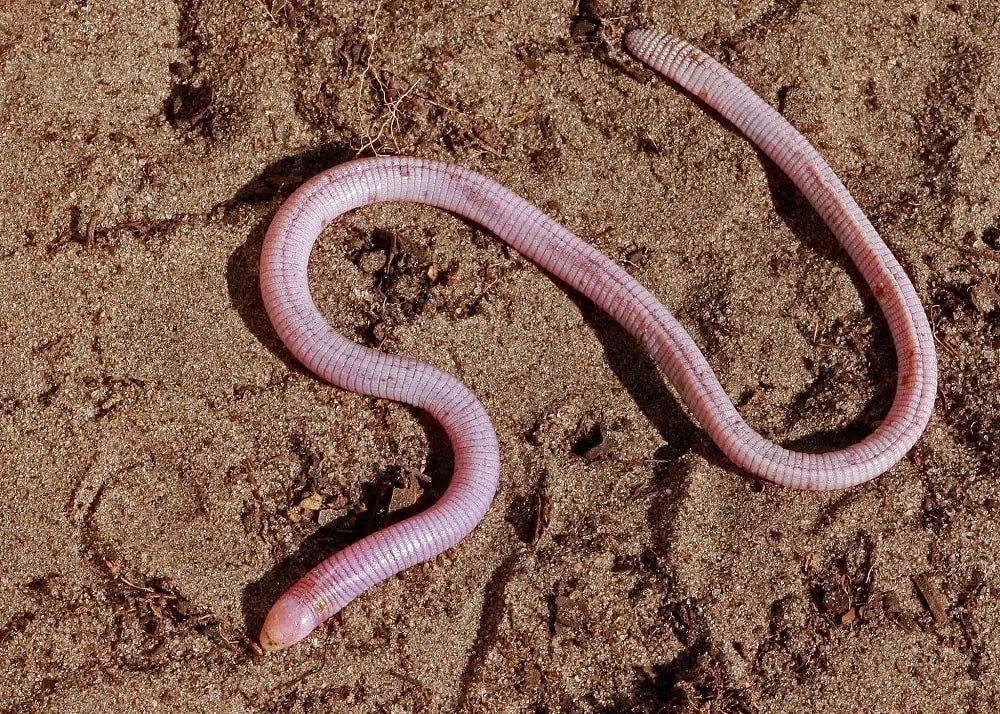
Scientific name: Rhineura floridana.
Common name: North American worm lizard, Florida worm lizard, graveyard snake, thunderworm.
Florida worm lizards or Rhineura floridana are native to Florida and come from the Rhineuridae family. While they are found primarily in Florida, they have been seen as far as Georgia. There are no reported subspecies.
These lizards vary in length with total lengths up to thirty centimeters or twelve inches. They have a shovel like snout, their eyes are not visible and neither are their limbs, which gives them a worm like appearance.
These lizards love to burrow and prefer rotting leaves, sand and soil. They spend most of their time burrowed in the ground, protecting themselves from predators. They leave the burrow after rain.
These lizards eat mostly earthworms and insects, though they are opportunistic eaters, eating any invert it can eat with ease.
Further Reading:
finding brown anoles with red top on heads
While I was driving home today in Southwest Florida I saw a lizard that was about 12-15 inches long in total, with a black head and tail, a lighter gray or whitish colored belly, and a bright either red or orange colored back. It ran pretty fast, right in front of my car and across the street. It had an upward stance, similar to that of an anole, but it did not resemble any anoles that I’ve ever seen. I’ve searched for images based on a brief description of what I said here, but I’ve not found anything similar. Do you know what kind of lizard this could be?
Are there significant populations of Texas horned lizards? They were very common in Texas when I lived there in the ’50s, but now there are efforts to restore populations by releasing captive bred lizards.
Not really. There are just a few records of Texas horned lizards in Florida.
Lived in South Florida for 55 years and today I saw a new one. It was about 12 long. Very thick with clawed tips. Colors were similar to a bufo toad but the lizard was skinnier. It’s eyes were toad like. Very shiny skin like a snake. Not scared at all. Light brown with dark brown spots and striping towards the sides of the back. No defined neck.